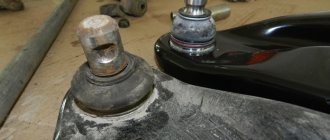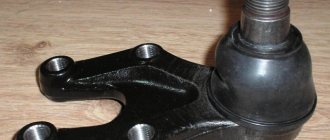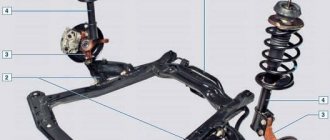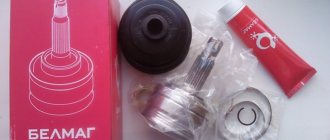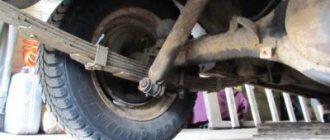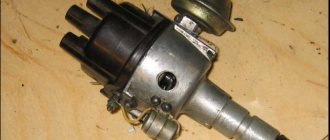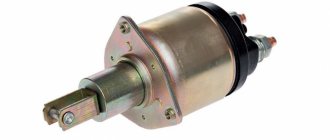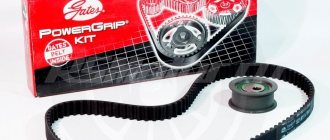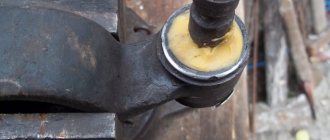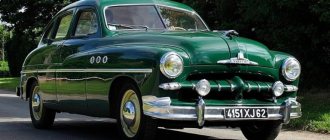One of the most important elements of the front suspension is the ball joint. True, they used to be used on the rear axle, but these were isolated cases when the rear wheels were able to steer in time with the front ones (nowadays this design is practically not used). The support, as a support bearing itself, allows your wheels to deflect (simply turn), without this design this would not be possible. In this article I will talk about the device, how it works and whether it can be repaired to make it last forever. In general, as usual, there will be a lot of useful information, so continue reading...
Why do you need a ball joint?
A ball joint is, structurally, nothing more than a hinge with which the wheel hub is attached to the suspension arm. Its main task is to give the wheels freedom of movement in the horizontal plane and exclude it in the vertical. In general, ball joints are used not only in hub supports - they can be found in camber arms, in the steering linkage, and even in fastening the hood gas stops.
But until a certain time, instead of movable ball joints on swivel wheels, a kingpin joint was used - heavy, requiring periodic lubrication, and most importantly, providing the wheel with only freedom of rotation along one axis, which negatively affected handling.
The designers understood that the ball joint would take every hit from the road, so the wear and tear would become colossal. There was no point in making a part with particularly durable diamond coating, so it was deliberately turned into almost a consumable. So that if something happens, you can easily unscrew a couple of bolts and a nut and replace it with a new one.
Useful tips
The service life of a support often depends on a lot of factors and on average ranges from 15 to 120 thousand kilometers. The life of a ball joint can be shortened by even a minimal crack in the boot. Water, sand and dirt can penetrate through it into the hinge. To prevent damage to the ball joint, the condition of the rubber protective boot should be monitored. It is advisable to do this on an overpass or inspection hole.
Read also: Meeting a guy's mother
In order for ball joints to last longer, you need to drive carefully on broken road surfaces and change damaged boots in a timely manner. Do not forget that any vehicle mechanisms and components require regular maintenance and repair. You can learn more about replacing ball joints in this video.
This is interesting: How to change a Duster low beam bulb
Device
Technical progress has led to changes in the original design of ball joints, although they were not fundamental. The stamped halves of the body, connected by spot welding, were replaced by cast and dismountable supports - with a threaded cover, maintenance-free and serviceable - with grease fittings. These improvements were justified and useful. Today, the most common maintenance-free ball joint design consists of: a body with a spherical recess and a pin with a ball on one end and threads on the other. The boot, placed on the finger, prevents moisture and dirt from entering the housing filled with a special thick lubricant.
The main function of the ball joint is to ensure its fixed position in the horizontal plane during vertical movement of the wheel. The ball pin can rotate in the body, swinging at small angles. That is, in the plane of its attachment, the ball joint provides simultaneous rotational and linear (limited) movements of the finger.
All parts of the ball joint are usually made of steel. To reduce friction of contacting working surfaces, the spherical recess of the housing is covered with plastic or other polymer material. However, there are ball joints that do not include a polymer coating between the body and the pin. This applies, first of all, to outdated domestic cars. These models were equipped with collapsible ball joints, in which backlash was eliminated by tightening the cover.
There are two ways to attach the ball joint. In the first case, it is bolted to the lever. In the second, it is pressed into it. If a bolted ball joint fails, it can be replaced with a separate unit. To do this, you just need to buy and install it by bolting it to the lever. In the second case, you will have to change the suspension arm with a pre-installed, pressed-in ball joint. The cost of such repairs is much higher, since it also includes the cost of the lever.
Press-fitted ball joints are typically installed on Japanese-made vehicles. Asian manufacturers of auto parts offer consumers ball joints for such cars in the form of separate units. This is much cheaper, but you should be aware that their quality is significantly inferior to the original, and the lever will have to be remade in a “makeshift way”, turning it into a part that is not subject to warranty repair
Anther
A mandatory attribute of the main suspension joint is the boot. It is used on both removable and non-removable structures. The part is a replaceable one. Experts recommend monitoring its condition at least every 10-15 thousand km. mileage Timely replacement of a worn boot will help save on repair/replacement of the entire ball joint. Its task is to block the penetration of moisture, dust and dirt to friction surfaces, which contribute to rapid wear of metal parts.
Diagnostics and replacement
If, when directly turning the steering wheel of a vehicle, the motorist needs to make special efforts or a characteristic creaking occurs, then most likely there are problems with the ball joint. In addition, this will also be indicated by the occurrence of a knocking sound when the car is moving at low speeds on uneven surfaces. Another sign of failure of ball bearings is wobbling and instability of the front wheels when moving directly in a straight line. Another sign of this problem is uneven wear on the vehicle's tires.
It is quite clear that a quick and high-quality replacement of the entire ball joint device will be possible only with the help and operation of professionals. However, many car enthusiasts prefer their own labor and work. In the modern world, the question of the production of ball joints finds its answer in the thesis that this is a high-tech process that allows us to achieve a high degree of reliability and durability. However, replacing this device is one of the most common types of car repairs. The situation, of course, can in no way change until the quality of our domestic roads changes.
Signs of element failure
So, we answered the question: “Car ball joint: what is it?” Now it is necessary to determine when this element becomes unusable. Among the main symptoms here are:
- noise from the suspension at low speed when overcoming various road obstacles (depressions, speed bumps, etc.). In this case, the sounds come from the front of the car. As a rule, this is caused by mechanical failures and reduced lubrication levels. In addition, the sound often appears in winter even under normal operating conditions of the unit;
- the wheels swing to the sides during straight-line movement. This indicates the presence of play in the support. This type of problem is very serious, since a strong tilt can lead to a complete twisting of the wheel;
- uneven wear of car tires. It is worth noting that such a symptom in itself can lead to the supports failing;
- When you turn the steering wheel you hear squeaks.
Having discovered such a malfunction, you should begin repair work as quickly as possible.
How does it work?
As you understand, a closed “ball” can rotate in any direction, even spin. A fixed mount is attached to the cylindrical body, which is installed in the necessary suspension elements - this part is not movable. But the upper threaded pin is attached to the moving parts, thanks to which they can turn or even rotate.
In old rear-wheel drive cars, for example our VAZs, there were about 3 ball joints. Two were located in the burdocks and allowed the caliper to rotate along with the wheel. One was located in the steering rod and pushed the wheels.
The MacPherson suspension has greatly simplified the design. Here, as we know, there is a support bearing and it allows the strut and caliper to rotate, but the ball joint remains at the bottom. There are also steering links that push the calipers, causing the wheels to turn. There are only two ball joints here.
It is also worth mentioning that there are options with four supports, but they are quite rare and should not be considered.
Now there may be objections - that the ball joint and the steering tip are not the same thing. Guys, the only differences are in the mounting of the case, the essence of the work is the same.
If we summarize the work, the following comes out: you turn the steering wheel, the force passes through the steering rack to the caliper, and in order for it to turn, hinge joints are needed, this is exactly the work that the supports, steering tips and, of course, the support bearing do.
Successful design is the key to success
So, it’s time to find out what the secret of the ball joint is, and to do this, let’s look at its design. Let's be honest - there is nothing supernatural in it, and on the contrary, it is an extremely simple mechanism.
The average ball joint of a modern car consists of the following elements:
- a rod with a spherical tip on one side and an element for fastening to the suspension arm on the other;
- cylindrical metal body;
- polymer liner;
- a pressure washer that secures the previous part in the body;
- boot - a rubber shell that ensures its tightness.
As we can see, there is nothing complicated, and the attached illustration quite clearly lets us understand how everything works.
Modern ball joints are consumables, that is, they are maintenance-free and, in the event of failure, can only be replaced.
Previously, designers took a more rational approach to these parts, and provided them with special holes through which lubricant could be pressed inside, but nowadays this is irrelevant, because thanks to the high-strength plastics used for the liners, these suspension elements can travel up to 150 thousand kilometers without any problems .
Causes and consequences of ball joint failure
As mentioned above, the support was invented as a replacement for the pivot, but getting rid of it did not get rid of the forces acting on the hinge. If you ask an almost philosophical question: “So why do ball joints wear out?”, then the answer will consist of three main points (there is also a fourth - time - but it is not interesting, since it is understandable).
First: increased shock loads on the suspension when driving, for example, along tram tracks at indecent speeds or normal vehicle operation in unusual road conditions, which will not surprise us. Second: lack of lubricant where it should be (remember the grease fittings?). And finally, third: destruction of the support boot.
As for the design features of suspensions and the effect of this on wear, we can say the following: any ball joint, no matter how it is installed - on the lever or on the steering knuckle - will wear out due to shock and friction. And if you want to save money and nerves, then you need to look behind the wheel more often, and also not shout “Banzai” to yourself when you see approaching misunderstandings in the form of potholes.
Mounting methods
Install a new ball joint by threading its pin into the hole in the steering knuckle, install a washer on top, screw on the slotted nut, tighten it, and secure it with a cotter pin. The assembly is secured to the lever with three bolts. Thanks to this design, the wheel occupies a fixed position relative to the vehicle body, and at the same time turns in the desired direction, freely overcoming small obstacles and uneven hard surfaces.
Depending on the suspension device and the make of the car, the ball joint can be attached in a different way. There are options for mounting it into the lever using a press and fixing it with a locking ring. On the Niva, the hinges are turned upside down and are screwed to the lever not from the inside, but from the outside.
Ball joint repair
There are several repair methods. Often, the ball joint is replaced with a new one. Replacing a support along with a lever on most foreign cars is a very expensive pleasure, since the price of one lever is not a small amount, and there are also cars that have complex multi-link suspensions (up to 5 on one side only). The cost of the work performed will also be quite high for the lower lever, and twice as much for the upper one. Therefore, the services of restorers who repair even those supports that are replaced in the assembly with a lever are in great demand.
Restoration is much cheaper than purchasing a new part. This is especially noticeable for supports that come complete with arms. Various technologies can be used to restore them.
- The easiest one is to convert the ball joint into a collapsible one, change the plastic inserts and polish the pin.
- A somewhat labor-intensive technology - the housing is filled with liquid polymer under pressure. Next, this polymer hardens in the gaps. The pressed supports into the levers are first removed and then replaced with non-original supports.
Remember that such savings may cause troubles on the road; to avoid this, it is recommended to use new components.
Checking the condition of the hinge
For diagnostics, it is best to use a lift or inspection hole. The wheels are hung out, the surrounding area is illuminated with a good light source. To increase the applied force, use a pry bar inserted between the steering knuckle and the lever. The presence of even a slight play indicates a defect in the sealing liner and an increase in the gap.
How to check a ball joint using this method - in the video:
A less common way is to measure the distance between the base and the finger . This is possible if the shell has a hole for an oiler. The car is driven onto a flat area above the inspection hole, and the plug (oil nipple) is unscrewed. Determine the distance from the rod to the lower plane of the body. In the new spare part it is 11.8 mm. For measurements, use a caliper or a bore gauge. This method is suitable for serviceable hinges where there is a service hole for an oil nipple.
